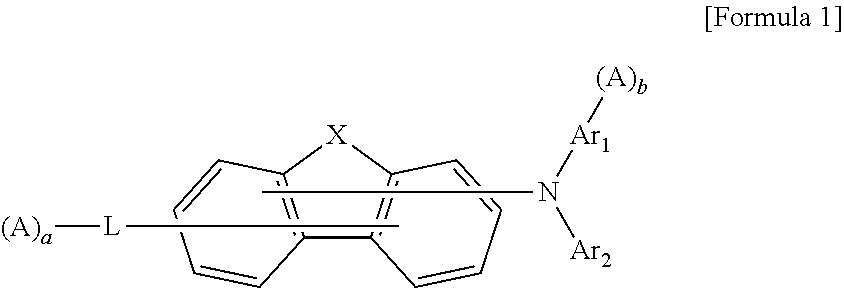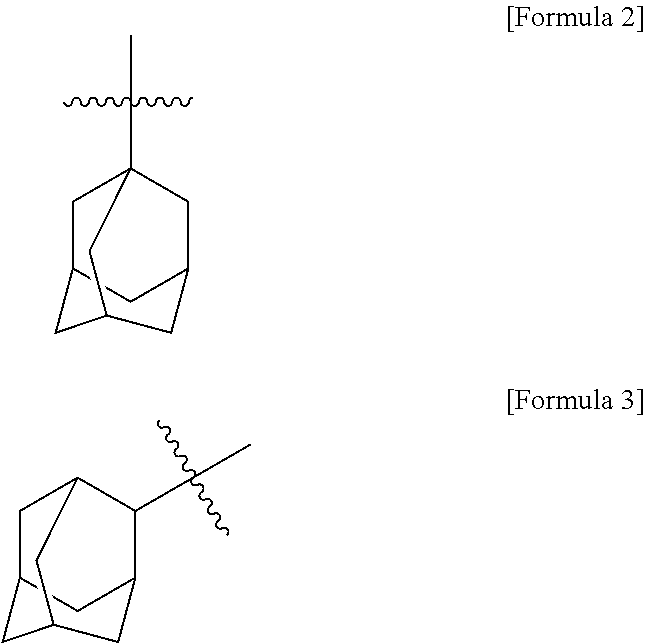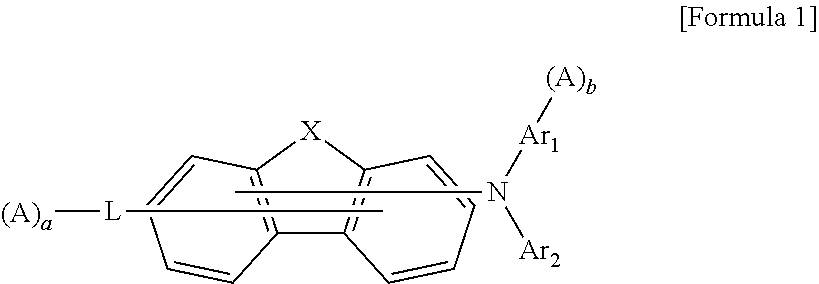Organic compound and organic electroluminescent element comprising same
a technology of organic compound and organic light-emitting diode, which is applied in the direction of luminescent compositions, organic chemistry, chemistry apparatus and processes, etc., can solve the problems of reduced light-emitting efficiency, reduced current efficiency, and high thermal stability of organic material used in oled, and achieve excellent chemical stability, low crystallinity, and high thermal resistance
- Summary
- Abstract
- Description
- Claims
- Application Information
AI Technical Summary
Benefits of technology
Problems solved by technology
Method used
Image
Examples
synthesis example 1
ound 1
[0074]
[0075]54.1 g (0.15 mol) of 4-(adamantane-1-yl)phenyl trifluoromethanesulfonate and 28.1 g (0.18 mol) of (4-chlorophenyl)boronic acid were dissolved in 800 ml of toluene, and 200 ml of ethanol, 200 ml of water, 62.2 g (0.45 mol) of potassium carbonate, and 5.2 g (4.5 mmol) of tetrakis(triphenylphosphine)palladium(0) were added thereto, followed by refluxing for 12 hours. After the reaction was completed, the resulting solution was cooled to room temperature, and then an organic layer was extracted using 500 ml of dichloromethane and 300 ml of H2O. Following dehydration of the organic layer with MgSO4, the remaining solution was distilled, subjected to column chromatography using dichloromethane, and then recrystallized using n-hexane / dichloromethane, thereby obtaining 41.2 g of 1-(4′-chloro-[1,1′-biphenyl]-4-yl)adamantane with a yield of 85%.
[0076]5.42 g (15.0 mmol) of N-([1,1′-biphenyl]-4-yl)-9,9-dimethyl-9H-fluorene-2-amine and 5.33 g (16.5 mmol) of 1-(4′-chloro-[1,1′-b...
synthesis example 2
ound 110
[0077]
[0078]108 g (0.50 mol) of 1-bromoadamantane was added to 188 g (2.0 mol) of phenol, and heated at 120° C. for 12 hours. After the reaction was completed, the resulting solution was cooled to room temperature and stirred in a beaker containing 2 L of hot water, thereby forming a precipitate. After filtering, the precipitate was washed three times with hot water and sufficiently vacuum-dried, thereby obtaining 91.3 g of 4-(adamantane-1-yl)phenol with a yield of 80%.
[0079]91 g (0.40 mol) of 4-(adamantane-1-yl)phenol and 63 g (0.80 mol) of pyridine were dissolved in 500 ml of dichloromethane and cooled to 0° C., and then 135 g (0.48 mol) of trifluoromethanesulfonic anhydride was slowly added. After the reaction was completed with stirring for 3 hours, 1 N hydrochloric acid and 300 ml of water were sequentially added to the resulting solution for extraction. Following dehydration of the organic layer with MgSO4, the remaining solution was distilled and subjected to column c...
synthesis example 3
ound 6
[0082]Compound 6 was prepared by the same method as described in Synthesis Example 1, except that 5.42 g (15.0 mmol) of N-([1,1′-biphenyl]-2-yl)-9,9-dimethyl-9H-fluorene-2-amine and 5.33 g (16.5 mmol) of 1-(4′-chloro-[1,1′-biphenyl]-4-yl)adamantane were used.
PUM
| Property | Measurement | Unit |
|---|---|---|
| glass transition temperature | aaaaa | aaaaa |
| Tg | aaaaa | aaaaa |
| Tg | aaaaa | aaaaa |
Abstract
Description
Claims
Application Information
 Login to View More
Login to View More - R&D
- Intellectual Property
- Life Sciences
- Materials
- Tech Scout
- Unparalleled Data Quality
- Higher Quality Content
- 60% Fewer Hallucinations
Browse by: Latest US Patents, China's latest patents, Technical Efficacy Thesaurus, Application Domain, Technology Topic, Popular Technical Reports.
© 2025 PatSnap. All rights reserved.Legal|Privacy policy|Modern Slavery Act Transparency Statement|Sitemap|About US| Contact US: help@patsnap.com



